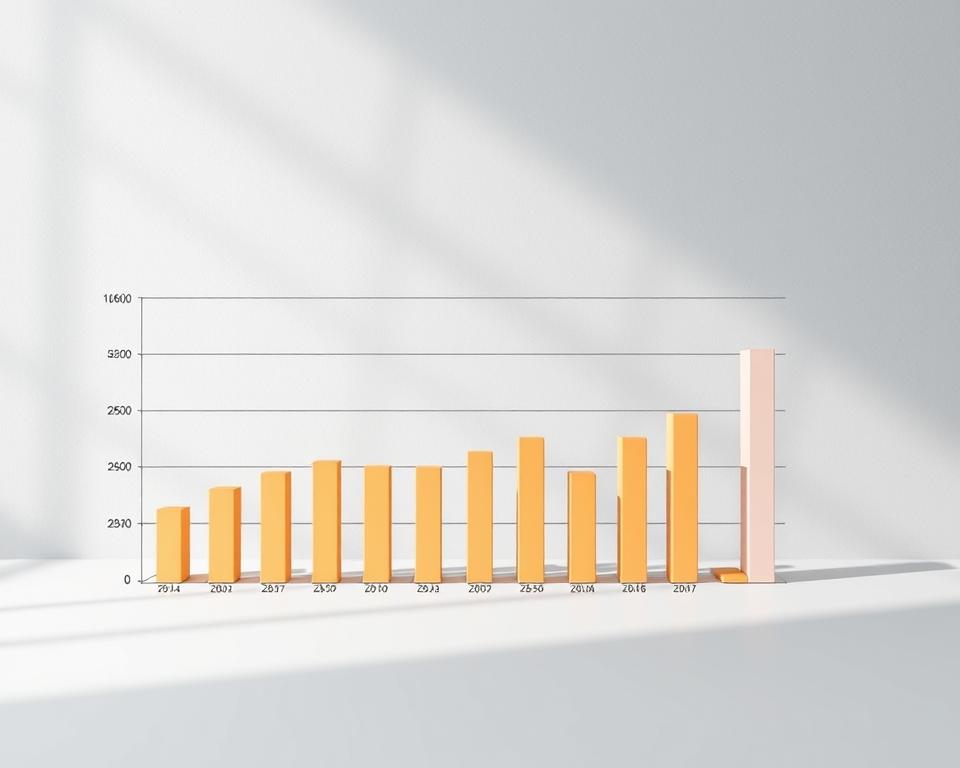Imagine getting a steady paycheck without working. Federal Realty Investment Trust (FRT) has done this for 57 years, increasing dividends every year. It offers a 4.5% yield.
Other companies like NNN REIT (NNN) and Essex Property Trust (ESS) have also grown their dividends for many years. This shows that investing in top dividend stocks can be very rewarding. These companies are leaders in real estate and other industries, providing both high yields and stability. They are also part of major stock indexes like the S&P 500 or Russell 2000.
Dividend stocks like FRT, NNN, and ESS focus on steady income. Federal Realty invests in upscale retail, NNN has long-term leases, and Essex focuses on apartments in high demand. Their strategies keep cash flows steady, even when the market changes.
But there are many other options. Over 20 companies listed here offer different ways to earn passive income. From shipping with Genco Shipping to banking with First Interstate BancSystem, each has its own strengths.
Key Takeaways
- FRT’s 57-year dividend streak and 4.5% yield highlight long-term reliability in dividend stocks.
- NNN’s 5.5% yield and low payout ratio show how net lease properties stabilize income.
- Essex Property Trust’s 31-year growth ties apartment demand to steady cash flow.
- Top performers include companies from shipping (International Seaways) to media (Gray Media Inc).
- Many listed stocks are S&P 500/Russell 2000 members, blending safety with growth.
Introduction to Dividend Stocks
Dividend investing is a way to get steady returns from companies that share profits. It’s about picking stocks that pay out well while growing over time.
What Are Dividend Stocks?
Dividend stocks are shares in companies that give some of their earnings to investors. These payments, often every quarter, come from the company’s profits. The board of directors decides how much to pay out.
- Payment Types: Cash or additional shares
- Dividend Yield: Annual dividend as a percentage of stock price
- Payout Ratio: Measures sustainability by comparing dividends to earnings

Why Consider Dividend Investing?
Investors choose dividend stocks for steady income and a stable portfolio. Here’s why:
- Passive Income: Regular payouts help with retirement or daily expenses.
- Tax Efficiency: Qualified dividends get lower tax rates.
- Financial Health Indicator: Companies with steady dividends usually have good cash flow.
Dividend investing combines income with growth. It’s a key part of many long-term financial plans.
Benefits of Investing in High Dividend Stocks
High dividend stocks offer a steady income and chances for long-term growth. They come from companies with solid financial health. This makes them a dependable choice for earning passive income. Investors get regular payouts and may also see their stock value increase.

- Steady income streams with predictable payouts reduce reliance on stock price swings.
- Companies raising dividends often signal financial stability and confidence in their future.
- Lower volatility compared to growth stocks makes them less risky in turbulent markets.
- Reinvesting dividends compounds returns, accelerating wealth growth over time.
- Qualified dividends taxed at lower capital gains rates if held for at least 60 days.
Many investors choose high dividend stocks for their ability to generate income and provide stability. By focusing on companies with a history of increasing dividends, you can build a strong portfolio. These stocks often perform well during tough times, balancing safety with growth.
Evaluating Dividend Yield and Payout Ratios
Investors looking at dividend stocks need to check two key numbers: dividend yield and payout ratios. These figures show how much income a stock can give and if it’s financially stable. 
Understanding Dividend Yield
Dividend yield tells you how much income you get from a stock each year. For example, Federal Realty Investment Trust has a 4.5% yield. This means you get $4.50 in dividends for every $100 you invest. But, always look at payout ratios to make sure the dividend is safe.
- Formula: Annual dividend per share ÷ stock price × 100
- Compare yields to industry peers to spot opportunities
- High yields without strong payout ratios may signal risk
Calculating Payout Ratios
Payout ratios show how much of earnings go to dividends. A ratio under 50% means earnings can cover dividends easily. But, a ratio over 100% means dividends are not sustainable.
Here’s how to check if dividends are safe:
- Divide dividends per share by earnings per share (EPS) to get the payout ratio
- Check if FCFE (free cash flow to equity) covers dividends fully
- Aim for net debt/EBITDA ratios below industry norms to avoid debt stress
Investors should also look at dividend coverage ratios. A ratio above 2x means earnings can easily support dividends. Using FCFE and net debt/EBITDA adds more insight to your analysis.
Dividend Growth and Company Performance
Dividend growth stocks show a company’s financial strength. For example, Essex Property Trust has raised dividends for 31 years. This shows strong management and profit.
Watching how dividends grow helps investors see if a company is reliable for the future.
Analyzing Dividend Growth Trends
Let’s look at Visa and Verizon over 16 years. Visa’s dividend yield went from 0.2% to 0.73%, beating Verizon’s 5.6% to 6.74% rise. Visa’s 12% yearly return is higher than Verizon’s 7.8%.
This shows that dividend growth is linked to total returns. Dividend growth stocks tend to do better with less ups and downs.

Assessing Company Financial Health
Healthy dividend growth stocks keep their payout ratios in check. For instance, Alimentation Couche-Tard did better than BCE with 18% more returns. Companies with lots of cash, like the S&P 500’s $1.8T in 2024, are stable.
Look for companies with good payout ratios and earnings growth. For example, 15% EPS growth is expected in 2025.
- Starlight Dividend Growth Class fund had 40 dividend hikes in 2023, with an average of 11.64% increases.
- The S&P 500 saw 7.6% dividend growth in 2024, with a 4.2% estimate for 2025.
Investors should focus on companies that grow but also stay financially strong. By following these trends, you can make smart choices in dividend growth stocks and avoid big risks.
Dividend Stocks: A Path to Reliable Passive Income
For those looking to create steady income, dividend paying stocks are a smart choice. They offer both current income and the chance for your money to grow. This makes them key for building wealth and securing retirement.
Key Characteristics of Dividend Stocks
Good dividend paying stocks have a few things in common. They focus on steady cash flow, not just quick profits. This means they can keep paying out even when the market is shaky.
Take Federal Realty Investment Trust (FRT) for example. It has paid out dividends for 57 years. Others, like NNN REIT and Essex Property Trust (ESS), also have long histories of steady payouts. They focus on real estate and housing to keep their dividends strong.

Long-Term Growth
- AbbVie (ABBV) has a 3% yield and is investing in new drugs.
- Pfizer (PFE) offers a 6.6% yield, thanks to its vaccines and treatments.
- Chevron (CVX) is growing its production by 6%, supporting its 4.3% yield.
Companies like Brookfield show how dividends can grow faster than inflation. Retail giants like Target have kept paying dividends for 53 years, even in tough times.
By choosing these types of companies, investors can get both income and growth. This makes dividend paying stocks a strong way to build wealth over time.
Strategies for Building a Dividend-Paying Portfolio
Creating a dividend-paying portfolio needs careful picking of top dividend stocks and smart diversification. Look for companies with solid finances and a track record of steady dividend increases. Consider ETFs like the VanEck Durable High Dividend ETF (DURA), which picks stable income sources based on metrics like the Distance to Default score.

“The best dividend stocks combine high yields with sustainable growth.”
- Choose 20–60 stocks to spread risk evenly across holdings.
- Limit any sector to ≤25% of total portfolio exposure.
- Target companies with payout ratios ≤60% to ensure dividend safety.
- Include “Dividend Aristocrats” or “Dividend Achievers” with 25+ years of payout growth.
| Strategy | Guideline |
|---|---|
| Sector Diversification | Allocate across 5–7 industries |
| Position Sizing | Equal-weight each stock position |
| Risk Mitigation | Cap individual sector exposure at 25% |
Use DRIPs (Dividend Reinvestment Plans) to reinvest dividends and grow your portfolio. Stay away from high-yield traps by focusing on top dividend stocks that are financially strong. Mix dividend stocks with bonds for more stability. Check your portfolio regularly to make sure it meets your long-term income goals.
Risk Management in Dividend Investing
Protecting your investments is more than picking high-yield stocks. Good risk management keeps your income steady and avoids surprises.

Recognizing Market Risks
Watch out for these warning signs to steer clear of common pitfalls:
- High dividend yields might mean a company is in trouble—be wary of payouts that seem too good to be true.
- When interest rates go up, people prefer bonds over dividend stocks, which can hurt demand.
- Payout ratios over 80% of earnings can strain a company’s cash flow, leading to dividend cuts.
- Real estate and utilities face special challenges, like regulatory changes or economic ups and downs.
Diversification Techniques
Use these methods to balance your portfolio:
| Strategy | How It Works | Benefits |
|---|---|---|
| Sector Mix | Invest in utilities, healthcare, and tech to spread exposure | Reduces sector-specific volatility |
| Asset Allocation | Combine stocks with bonds or international equities | Smooths out market fluctuations |
| Geographic Spread | Include global companies alongside domestic holdings | Buffers against regional economic shifts |
Keep an eye on historical volatility and Sharpe Ratio to balance risk and return. Regular checks on cash flow and payout ratios help maintain stability over time.
Researching Top Dividend Stocks in the United States
Looking for top dividend stocks needs a clear plan. Start with reliable data and tools to make your search easier. Use free resources like the S&P 500 Dividend Aristocrats list. It shows companies with 25+ years of steady dividend growth.
These companies, like Realty Income Corp and Archer Daniels Midland Co, are stable and have good long-term returns.

How to Research Dividend Stocks
Follow these steps to make your research easier:
- Screen for quality: Use tools like Dividend.com to filter stocks by yield, payout ratios, and dividend ratings.
- Check fund options: ETFs like Vanguard Dividend Appreciation ETF (VIG) or SPDR S&P Dividend ETF (SDY) offer a mix of top performers.
- Review financial health: Look at earnings reports and compare metrics like P/E ratios to industry averages.
Evaluating Market Trends
Watch sector trends to find stable dividend stocks. Healthcare and utilities often have stable dividends. Use ETFs like WisdomTree US LargeCap Dividend ETF (DLN) to find new chances.
Check Morningstar ratings for funds to see if they match your goals. Premium tools like Dividend.com give future dividend estimates for members. This helps predict growth.
Keep up with quarterly earnings and economic forecasts. By following these steps, you can build a research process that fits your portfolio.
Tax Considerations for Dividend Income
Managing taxes is key to maximizing dividend earnings. Qualified dividends face lower rates than ordinary income, but rules vary. Here’s how to navigate them:
- Qualified dividends taxed at 0%, 15%, or 20% (capital gains rates)
- Ordinary dividends taxed as income at up to 37% federal
- Qualified status requires holding shares 61 days around ex-dividend dates
| Type | Tax Rate | Holding Period |
|---|---|---|
| Qualified Dividends | 0–20% (depends on income) | 61+ days |
| Ordinary Dividends | Up to 37% | No holding requirement |
Investors must track Form 1099-DIV for reporting. If ordinary dividends exceed $1,500, Schedule B is required. High-income earners may face the 3.8% net investment income tax (NIIT) if income thresholds are hit.
Strategies like holding in tax-advantaged accounts (IRAs) or timing sales can lower tax impacts. Always confirm holding periods and consult a tax advisor for personalized guidance.
Tools and Resources for Dividend Stock Analysis
Choosing the right tools can make dividend stock research easier. Sites like DividendData.com have special features to help you. They ensure you make smart choices fast.
Online Screening Tools
Begin with DividendData.com’s Stock Screener. It sorts through thousands of stocks by yield and payout ratios. It covers NYSE, NASDAQ, and AMEX, helping you find stocks for long-term growth.
- My Watchlist: Keep track of stocks with alerts for ex-dividend dates or price changes.
- Best Dividend Stocks List: Get access to pre-checked stocks with DARS™ ratings for stability and income.
Dividend Calculators and Software
Try the Compounding Returns Calculator to see income growth over time. The Dividend Assistant shows upcoming payouts and which stocks add to your monthly income.
- Monthly Income Generator: Find stocks with dividends in specific months to match your cash flow.
- Dividend Payout Changes Tracker: Keep an eye on companies changing their dividend policies to avoid surprises.
For those who want more, DividendData’s Portfolio Analyzer checks payout ratios and FCFE ratios. Look for FCFE ratios under 50% and net debt/EBITDA below the industry average. These signs point to healthier companies.
Conclusion
Dividend stocks are great for building passive income and wealth over time. Companies like Microsoft (MSFT) and Verizon (VZ) show how to balance growth with steady payouts. They offer yields of 0.87% and around 7%, respectively.
It’s important to watch the payout ratio. A ratio between 2-3 is good, but below 1.5 might be risky. Diversifying your portfolio across different sectors and yield levels helps protect it from market changes.
Tools like dividend screeners and calculators make finding good stocks easier. Look for companies with a history of growing dividends and stable earnings. Even starting with one quality stock can help build steady income.
Remember to consider taxes and avoid high yields without understanding the risks. Dividend investing is a long-term strategy that requires patience and careful research.
Use free resources to check dividend coverage ratios and growth trends. Whether you’re new or experienced, focus on safety and growth. This approach can make dividends a reliable source of income. Start exploring today and begin your journey to passive income.



